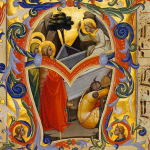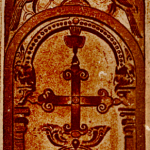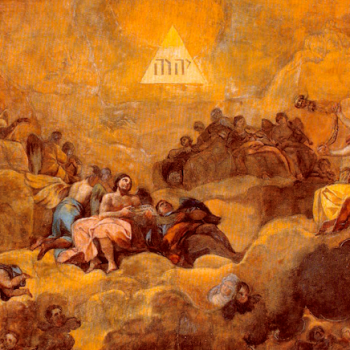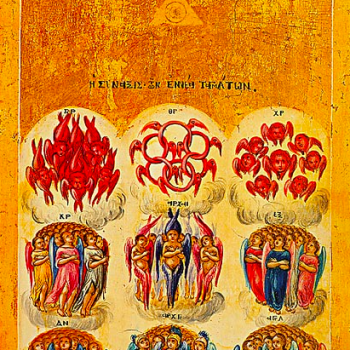This Easter, I Gave You My Post
This picks up from the post I published on and for the Easter Vigil; notes a-f can be found there. To keep anyone from having to tab back and forth, I’ve copied the Gospel passage (in both versions) into this post. (Verse 8, since it wasn’t in the actual reading for the Vigil, is in grey.)
Mark 16.1-7 +8, RSV-CE

And when the sabbath was past, Mary Magdalene,a and Mary the mother of James,b and Salome,c bought spices, so that they might go and anoint him. And very early on the first day of the weekd they went to the tombe when the sun had risen. And they were saying to one another, “Who will roll away the stone for us from the door of the tomb?”f And looking up, they saw that the stone was rolled back; for it was very large. And entering the tomb, they saw a young man sitting on the right side, dressed in a white robe;g and they were amazed. And he said to them, “Do not be amazed; you seek Jesus of Nazareth, who was crucified. He has risen,h he is not here; see the place where they laid him. But go, tell his disciples and Peteri that he is going before you to Galilee; there you will see him, as he told you.”j And they went out and fled from the tomb; for trembling and astonishment had come upon them; and they said nothing to any one, for they were afraid.k
Mark 16.1-7 +8, my translation
Once the sabbath had gone by, Miriam from Magdalaa and Jacob’s Miriamb and Salomec bought spices, in order that they might go anoint him. And very early on the first day of the week,d they came to the monumente at the coming-up of the sun, and were saying to each other: “Who will roll away the rock from the door of the monument for us?”f But, looking up by, they saw that the rock had been rolled away (it was extremely large). And going inside the monument, they saw a young man sitting on the right with a white garment thrown on,g and they were overawed. He said to them, “Do not be overawed: Jesus, you are looking for, the Nazarean who was crucified; he was raised,h he is not here. Look—the place where they put him; but go on and tell his students, and Rocky,i that he is going before you to the Galilee; there you will see him, just as he told you.”j And they went out and fled from the monument, for tremors had them out of their minds; and they told no one nothing, for they were afraid.k
Textual Notes, Resumed
g. a young man … dressed in a white robe/a young man … with a white garment thrown on: The most common term for angels in the Bible is “messenger,” but it does contain a few neaniskoi [νεανίσκοι], a few “young men,” that don’t seem actually to be young men. I’ve heard a theory that these should all be interpreted as human beings (don’t know how prevalent a theory it is, but I’ve heard it). This one could be a human being; he does nothing overtly miraculous, for instance; but, of all things, the fact he was dressed in white tells against it.
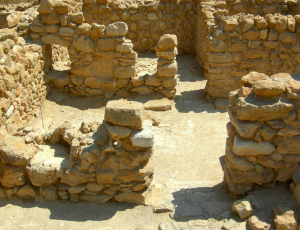
Part of the ruins of a major building at Qumran.
Contrary to popular belief—founded largely on illustrations that, from a mixture of some illustrators’ ignorance and conventional visual symbolism—white was not actually a favored color for clothing in first-century Palestine. Textiles at the time were mostly linen or wool, sometimes cotton, and none of these are naturally white—without dye, they tend to hover somewhere between the current/English meaning of the obnoxious word “ecru” and the archaic/French meaning of the term. Unbleached cloth was used, certainly (particularly among the poor), but bold colors like yellow, black, and red were generally preferred, along with purple and blue among the wealthy. True white was somewhat hard to achieve, and—remember, this is a world where everything either gets washed by hand or doesn’t get washed—is terribly easy to stain. Wearing white in first-century Palestine, eh? I sure hope you don’t plan to drink wine or be full of blood, or anything of that sort.
Now, one group was known for wearing white: the Essenes, of whom you may have heard. They were mystically-inclined millenarians who rejected the Temple system as corrupt. They are widely associated with the group at Qumran who probably made the Dead Sea Scrolls, which is likely enough. This has led to a perception that they were withdrawn from society, even hermitish—a belief I’ve fostered myself right here on this blog!—but that was my mistake, because it seems this is not really borne out by the sources we have about them (at least, not conclusively: it may have been true, or not). Connections have also been proposed between the Essenes on the one hand, and both John the Baptist and Jesus on the other. The Essenes practiced many ritual immersions and had a strong apocalyptic theming in their material, and were among the few Judaic groups in history to esteem celibacy highly.
I have gotten a little more skeptical of this idea than I used to be. For one thing, the millenarianism of the Essenes was distinctly nationalist (in fact, it’s thought they were basically exterminated in the First Jewish War of 66-73), which the preaching of Jesus obviously was not. More than that, Jesus—even while prophesying its imminent replacement—affiliates himself strongly with the Temple and its sacrificial system, and with the Pharisees over and above any other sect of Judaism. Essene influence, sure, I’ll buy that there was some; but I doubt that even St. John the Baptist really was an Essene, and Jesus seems to have been perceived by both others and himself either as a highly eccentric Pharisee, or as a Jewish prophet whose theological “next of kin” lay in them, not the Essenes (whom none of the Evangelists even mention).
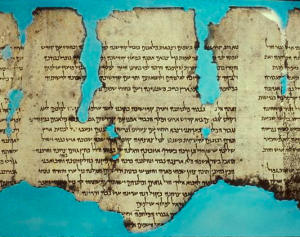
Part of the “War Scroll,” one of the many
Dead Sea Scrolls uncovered at Qumran
and thought to be by Essenes.
The point is, it is possible in theory that this neaniskos in Mark 16 was literally a young man, one with an odd taste in clothes and/or Essene connections, who happened to be hanging around the Holy Sepulcher, saw the Resurrection when it happened, and was accordingly handy to pass on a message from Jesus when the myrrh-bearers showed up—which, by happenstance, he was doing when (as the other three Evangelists report things) there were also angels around. I can’t speak for everyone, but I do not find this significantly more credible than just supposing that this neaniskos was an angel as well.
Intriguingly, the word here that the RSV translates as “dressed in,” and which I have as “thrown on,” is peribeblēmenos [περιβεβλημένος]—the same term used to describe the neaniskos from back in 14.51, who fled the scene in Gethsemane without the sheet of linen he had “thrown on.” It’s probable that this is only a coincidence of wording—young men and being dressed in front of people are not especially esoteric topics—but I can’t help wondering whether something more is concealed here that I haven’t put together.
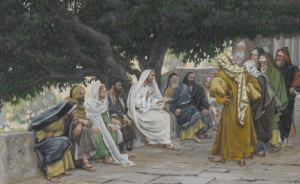
The Pharisees and Sadducees Come to Tempt
Jesus, James Tissot, 1850. Even Tissot—the
only good Biblical scenes painter!—fell victim
to the of-course-Christ-wore-white blunder.
h. his disciples and Peter/his students, and Rocky: At first this might sound a little harsh!—as if the angel were saying “Tell his students, and also that other guy who isn’t one of them anymore.” But this is a rare case where the niceties of a short, fairly ordinary word in the Greek have ramifications for the English. The word overwhelmingly translated “and” in this phrase (and everywhere else), kai [καὶ], technically is just a smidge closer in meaning to “also.” Ninety-nine times out of a hundred, “and” is going to be a decent translation; but at the right moment, or in the right tone, it can become “but,” “or,” “especially,” “even,” and so on. Here, I suspect that its primary force is clarifying: “tell his disciples (yes, including Peter)” being the sense of the text.
i. he is going before you to Galilee; there you will see him, as he told you/he is going before you to the Galilee; there you will see him, just as he told you: The as he told you part, I’m slightly puzzled by. Jesus foretold his Resurrection several times, but this makes it sound as if he prophesied that he would see the apostles again specifically in the Galilee—which, he did see them again there, and there’s certainly no reason he couldn’t have foretold that; I just don’t recall an instance in the Gospels of him making such a prophecy. Maybe he did and I’ve missed it somehow, or maybe he did and it wasn’t recorded; I don’t know. But the earlier part of the verse, instructing them to withdraw to the Galilee, is more illuminating.
The journey seems actually to have taken place about a week later: they were still holed up in the Upper Room after a week, when St. Thomas finally got in on the “no really, Jesus is alive” joke. But, if they were safe there, why leave at all? There are a few possible answers; one or more may be true.
It may have been routine. The Eleven all came from places in the Galilee; only Judas Iscariot shows any sign of being native to the old territory of Judah (the name Iscariot is of uncertain meaning, but may represent a Hellenization of ‘iysh-Qeriyowth [איש־קריות], “man [from] Kerioth,” a town about thirty miles south of Jerusalem). Under the circumstances, going north was just going home. Yet in that case, would they be given instructions to do that? Maybe; but I think there is room for further thought, and for alternative or supplementary ideas.
Second—it may have been a mere desire to give the Eleven a break. In an exceedingly short space of time, Jerusalem had gone from the geographical center of their faith to being that and also the site of some life-altering traumas that, additionally, turned out to be okay by way of something even more shocking than the traumas! It may be only my imagination, but I feel like you can almost hear a winded quality in the voice when, after they’ve gone north again, St. Peter says, “Well … I’m gonna go fishing, I guess.”
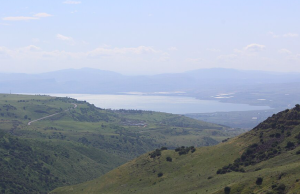
A view of the Sea of Galilee from the
Golan Heights. Photographed by
David Bena in 2016 and used under a
CC BY-SA 4.0 license (source).
Another question is: how safe, exactly, were they? This is a group of grown men, mostly manual laborers and/or former political malcontents (so, not delicate!), in a room in a private home belonging to an apparent ally—and they’re keeping the doors locked, they’re so afraid. Jesus may have been doing the thing that Caiaphas had thought he was doing or told himself he was doing, i.e. keeping the nation and the Temple as safe as possible for as long as possible. This may not seem transparent, to say the least! So let’s get in the weeds a little.
According to the canonical Gospels, as early as a week before Passover, Jesus had already begun what sounds like strategically concealing his movements. He stayed outside the city—presumably with sympathizers when in towns, like Ephraim or Bethany, and roughing it when on Mount Olivet—and “walked no more openly among the Jews,” except when he could either travel in big crowds, as on Palm Sunday (which he had apparently made arrangements for in advance, complete with a code phrase), or when he could enter and leave the city by night.
The reasons for this are not stated outright, but I don’t think they take much guesswork to divine. Bearing in mind that Jesus has already foretold his assassination multiple times, whatever he was doing by hiding his movements, it can be presumed that his own bodily safety was not his primary motive. The Twelve, though? There is a sense in which they’re as nearly important as Jesus.
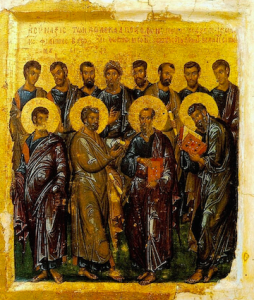
Fourteenth-century Russian ikon of the Apostles.
One of them, Judas Iscariot, is the lynchpin in actually effecting the sacrifice by which the New Covenant is to be ratified. Another, Peter, is Jesus’ own protégé, and in just a few years is to be the person who confirms the validity of the mission to the Gentiles. Two more, Matthew and John, are (on some showings) going to write two of the most important accounts of his life and work in history. And with the exceptions of Judas Iscariot** and St. James the Greater, who was called home early, the remaining ten—plus a surprise bonus apostle who shall be “born out of time,” and will need some filling-in from his predecessors—are elect as the principal means by which Jesus’ ministries of teaching, healing, baptizing, and absolving are to spread from Jerusalem through Palestine and from Palestine to the whole face of the earth.
But you know what’d throw a real wrench in all that? One or more of them following through on St. Thomas’s bright idea (expressed in John 11) of “dying with him,” either at the same time as the Passion, or in its immediate aftermath, while the Sanhedrin and the Roman officials alike are still jumpy. In fact, if a popular faith healer gets executed and then a handful, or a few handfuls, of his followers also get strung up shortly thereafter—gee, that sounds awfully like the makings of a popular revolt. That is coming eventually: it’s almost inevitable, given the Jewish dislike of being ruled by pagans and the Romans’ limited ability to grasp what matters to the Jews and why, and their vanishingly small desire to grasp it; and the Temple will be destroyed when it does. But surely there’s no need for that to come any sooner than it would otherwise. Given that forty years from now will be the hilarious clown show that is the Year of the Four Emperors away in Rome, while right now the government is under the control of the cruel, paranoid, and worst of all effective Emperor Tiberius, it might limit the casualties and destruction for the approaching revolt to take place in forty years and not now.
But as for now. Let things mellow for a few decades; establish lots of centers where Christianity is thriving, and at that point, sure, we can start sparing an apostle here and there—especially once they’re outside of the political powder-keg that is Judæa. Right at the start, how ’bout we all get out of Dodge, spend about a month around our old haunts to the north, and then come back for Shavuot like everyone else will be doing? Much cleaner.

Shavuot, or “the Feast of Weeks,” marks
the wheat harvest in Canaan, and was also
the date on which the Torah was given to
the Israelites, fifty days after the Passover.
Now, would “premature” deaths of the apostles be a completely solvable problem, for a Messiah who can literally raise the dead? Clearly, yes. Omnipotence has some resources at its disposal for solving problems. But, slow down: God seems rather, ah, economical with miracles for some reason. As Jesus says in Luke 4 to the people of Nazareth, “Many widows were in Israel in the days of Elijah, when great famine was throughout all the land; but unto none of them was Elijah sent, save unto a city of Sidon, unto a woman that was a widow. And many lepers were in Israel in the time of Elisha the prophet; and none of them was cleansed, saving Naaman the Syrian.”
I don’t know all the reasons for this, but I think I do know one. Miracles are not magic tricks performed to entertain a gawking populace. (Even John, the one Gospel that cites Jesus’ miracles as evidence of the legitimacy of his teaching and mission, occasionally acknowledges the dubious quality that miracle-inspired faith can have, in the same fashion as the Synoptics.) The fact that Jesus could have raised the apostles from the dead “on demand” does not necessarily mean that it would be consonant with the point of miracles for him to do so; miracles themselves, according to St. Athanasius, are mysteries writ large that God achieves through natural processes as a kind of small print all the time. Restoring the life of an apostle over and over like it’s a video game respawn ability seems … well, cheap. And its cheapness is most emphatically not the lesson God seems to want us to draw about life.
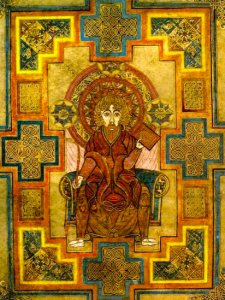
Portrait of St. John the Evangelist from
the Book of Kells, an evangeliary created
ca. 800 (regarded as the finest piece of
Insular art to survive the Vikings).
And going back briefly to that theme of giving the Eleven a break: from a purely human point of view, I dare say the apostles may have appreciated only needing to be martyred one time each.
j. trembling and astonishment had come upon them; and they said nothing to anyone, for they were afraid/tremors had them out of their minds; and they told no one nothing, for they were afraid: Obviously if this were absolutely true, we would know nothing about it, so presumably the part about “saying nothing to anyone” means they didn’t do so at first. In this setting, “at first” could mean a few different things, ranging from the next time they saw one or more of the Eleven to that day or even further out.
My personal guess is that this is in reference particularly to them crossing paths with SS. Peter and John. According to the Fourth Gospel, these two bolted to the tomb themselves more or less as soon as the Magdalene told them that the body was missing. (Someone, I forget who, also pointed out that this Gospel not only doesn’t say positively that the Magdalene went to the tomb all by herself, as I pointed out in my last: it actually implies the opposite in 20.2, in her use of “we.”) Given that the women would have been on their way to the Upper Room, it makes sense that they would have come within a few yards of the two apostles—but, being in shock (which I think is probably how we should interpret their “fear” here), they didn’t pause to speak to the pair then, instead just staying focused on the singular goal they were able to keep in their minds: Go to Upper Room. Tell men in Upper Room what just happened. Fin.
I’d like to close with a note on something that’s probably only coincidental, in the exact wording of the “tremors” that “had them out of their minds” at this time. Somewhat to my surprise, the verb there literally does say that “trembling had them,” though it actually makes it a compound subject, “fear had them and out-of-mind-ness,” though that translation is so literal you can probably guess why I chose not to use it. The word for out-of-mind-ness, however, pops up again frequently in the formal terminology of mysticism, and was eventually borrowed into English. The word in question is ekstasis [ἔκστασις], or in our idiom, ecstasy.
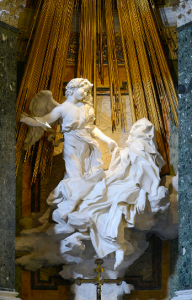
The Ecstasy of St. Teresa by Gian Lorenzo
Bernini, 1675. Used under a CC BY-SA
4.0 license (source).


